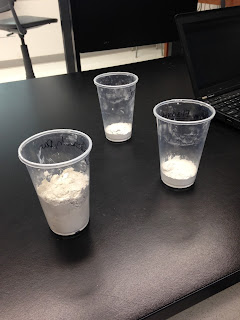Fossils "are the preserved remains or traces of animals, plants, and other organisms from the remote past." In my science class we talked about what fossils are and how to teach elementary students about them. Fossil toy eggs like the one in the picture below are expansive. They are great ideas for activities on teaching fossils, but they aren't exactly budget friendly. To surpass this expense we decided to make our own fossil molds out of plaster, sand and water.
Our Molds:
For our molds we decided to do three different experiments. We chose to keep sand as a constant and use 41.3 grams every time.
For Cup #1 we used 31.6 grams plaster, 41.5 grams of sand, and 25 ml of water
For Cup #2 we used 214.7 grams of plaster, 41.5 grams of sand, and 100ml
For Cup #3 we used 26.6 grams of plaster, 41.5 grams of sand, and 15ml of water
Once our fossils hardened, we cracked them open with hammers and chisels to look how our molds ended up. Molds one and two had molds the third did not. We didn't come up with a mold mixture that was...usable. The first mold needed more water, and a little more sand. It was very concrete. The second one was probably the best one of the three. It was almost usable in a class, but needed less plaster. It was a little too hard to get open because of all the plaster, but was still a little crumbly and moist. The third one chipped the shell, and fell apart because there was too much sand. That mix needed more plaster and a little more water with the plaster.
All in all this is a great activity for your students to do in your class, once you find the right mold mixture! Below are pictures of our fossil mold experiment:







No comments:
Post a Comment